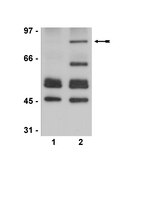06-758-25UL Sigma-AldrichAnti-acetyl-p53 (Lys373 Antibody, Lys382)
Detect acetyl-p53 (Lys373) with Anti-acetyl-p53 Antibody (Lys373, Lys382) (Rabbit Polyclonal Antibody), that has been shown to work in WB.
More>> Detect acetyl-p53 (Lys373) with Anti-acetyl-p53 Antibody (Lys373, Lys382) (Rabbit Polyclonal Antibody), that has been shown to work in WB. Less<<Recommended Products
Overview
| Replacement Information |
|---|
Key Specifications Table
| Species Reactivity | Key Applications | Host | Format | Antibody Type |
|---|---|---|---|---|
| Vrt | WB | Rb | Serum | Polyclonal Antibody |
| References |
|---|
| Product Information | |
|---|---|
| Format | Serum |
| Control |
|
| Presentation | Rabbit polyclonal antiserum containing 0.05% sodium azide. Frozen solution. |
| Quality Level | MQ100 |
| Physicochemical Information |
|---|
| Dimensions |
|---|
| Materials Information |
|---|
| Toxicological Information |
|---|
| Safety Information according to GHS |
|---|
| Safety Information |
|---|
| Packaging Information | |
|---|---|
| Material Size | 25 µL |
| Transport Information |
|---|
| Supplemental Information |
|---|
| Specifications |
|---|
| Global Trade Item Number | |
|---|---|
| Catalog Number | GTIN |
| 06-758-25UL | 04054839342462 |
Documentation
Anti-acetyl-p53 (Lys373 Antibody, Lys382) SDS
| Title |
|---|
Anti-acetyl-p53 (Lys373 Antibody, Lys382) Certificates of Analysis
| Title | Lot Number |
|---|---|
| Anti-acetyl-p53 (Lys373, Lys382) - 3318615 | 3318615 |
| Anti-acetyl-p53 (Lys373, Lys382) - 4124288 | 4124288 |








